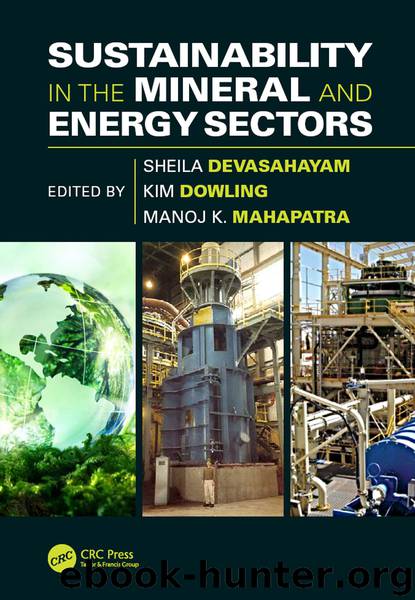SUSTAINABILITY IN THE MINERAL AND ENERGY SECTORS by SHEILA DEVASAHAYAM KIM DOWLING and MANOJ K. MAHAPATRA

Author:SHEILA DEVASAHAYAM, KIM DOWLING and MANOJ K. MAHAPATRA
Language: eng
Format: epub
Publisher: CRC Press
FIGURE 20.7 Water use by region for hydraulic fracturing in the United States. (Adapted from Gallegos, T. et al. 2015. Water Resources Research, 51(7): 5839–5845.)
The advantages of the larger hydraulic fracturing efforts is that more oil and NG can be produced per well. Based on current estimates of a yield of 50–170 million cubic meters of NG per well, the actual water use per MMBTU is not much different than conventionally produced NG, about 8 L/MMBTU versus 5 L/MMBTU. While data are more widespread for shale oil development with hydraulic fracturing, the trends suggest similar results, that the water use intensity is likely to be the same or even less than for conventional oil extraction. These values are both presented in Table 20.5. Therefore, while the newer nontraditional oil and NG extraction technologies seem to use more water, the overall water use intensity has not changed. But locally, the high volume of shale gas and shale oil wells drilled in such a short period in some regions could have significant impacts on local water resource sustainability.
The biggest environmental issue documented with hydraulic fracturing is poor surface completions through shallow fresh groundwater aquifers, and surface water contamination from surface water pits. Figure 20.8 shows a typical horizontal well drilling pad in the eastern United States, showing the typical surface disposal and mud pits (GWPC, 2009). This type of drilling pad layout is also typical of conventional oil and gas well development such that the operations of conventional and nonconventional extraction are very similar. If these surface pits are not lined or maintained properly, they can leak or spill fracked or produced water into surface water systems. Disposal of the hydraulic fracturing flow back and produced water, because of the high salt content generated on contact with the shales, continues to be a major environmental and cost concern for its disposal and reuse.
Download
This site does not store any files on its server. We only index and link to content provided by other sites. Please contact the content providers to delete copyright contents if any and email us, we'll remove relevant links or contents immediately.
International Integration of the Brazilian Economy by Elias C. Grivoyannis(99091)
The Radium Girls by Kate Moore(11976)
Turbulence by E. J. Noyes(7981)
Nudge - Improving Decisions about Health, Wealth, and Happiness by Thaler Sunstein(7659)
The Black Swan by Nassim Nicholas Taleb(7059)
Rich Dad Poor Dad by Robert T. Kiyosaki(6515)
Pioneering Portfolio Management by David F. Swensen(6258)
Man-made Catastrophes and Risk Information Concealment by Dmitry Chernov & Didier Sornette(5957)
Zero to One by Peter Thiel(5736)
Secrecy World by Jake Bernstein(4703)
Millionaire: The Philanderer, Gambler, and Duelist Who Invented Modern Finance by Janet Gleeson(4425)
The Age of Surveillance Capitalism by Shoshana Zuboff(4248)
Skin in the Game by Nassim Nicholas Taleb(4205)
Bullshit Jobs by David Graeber(4142)
The Money Culture by Michael Lewis(4136)
Skin in the Game: Hidden Asymmetries in Daily Life by Nassim Nicholas Taleb(3962)
The Dhandho Investor by Mohnish Pabrai(3726)
The Wisdom of Finance by Mihir Desai(3698)
Blockchain Basics by Daniel Drescher(3542)
